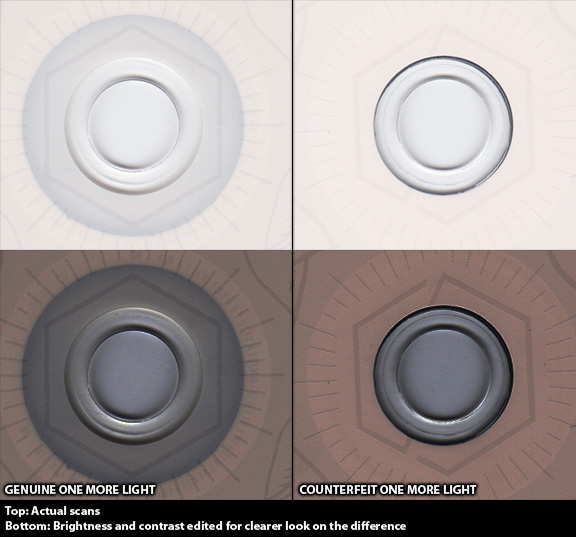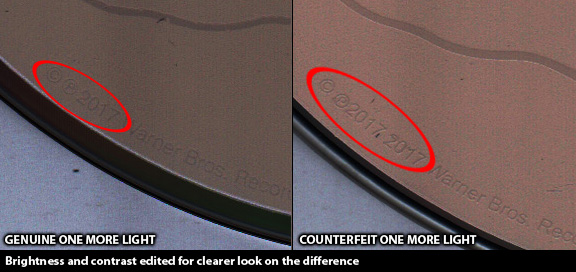One More Light Counterfeits
Some European One More Light counterfeits have been circulating! A write up below will show you the true method to knowing the differences between a legit copy and a fake! Please check with LPCatalog staff before you purchase any physical media that you suspect may be a fake.
Before we go “into the matrix” you need to know what an SID Code is.
The Source Identification Code (SID Code) has become the industry standard for indicating the source of optical disc mastering and replication. Each production facility that wishes to implement the use of the SID Code is issued with its own unique code(s). SID Code is an anti-piracy tool developed by IFPI and Philips in order to track the source of optical discs mastering and replication. A mastering/replication plant must incorporate a source identification code in the production of all masters, stampers and optical discs.
Since not all plants have both mastering and replication facilities, there are two codes:
- LBR or Mastering Code that identifies the plant that manufactured the master
Format: IFPI LXXX (alphanumeric digits)
The 3 alphanumeric digits identify the plant and LBR that manufactured the master or stamper used for disc production. - Mould Code that identifies the plant where the disc was replicated
Format: IFPI XXXX (alphanumeric digits)
The first two digits identify the manufacturing or mastering plant.
Now we can better understand the difference between a genuine One More Light European release and its counterfeit copy. Let’s take a look at scans below

You can see the SID Codes on both matrixes.
The Mastering code is the same for both CDs and it reads IFPI L016, the last three digits identify WME (Warner Music Manufacturing Europe).
This is the plant that manufactured the master, and that’s correct since we’re considering the European copy of One More Light.
Now let’s go into the tricky part… The Mould code is IFPI 054I on the genuine copy, the first two digits identify Alsdorf, Germany as the mastering and manufacturing plant.
WME has its own plant for mastering in Europe and it’s located in Alsdorf and the codes confirm that.
Now onto the fake!
What happens with the counterfeit copy?
The mould code is IFPI 08N5, meaning the first 2 digits identify Azcapotzalco, Mexico as the mastering and manufacturing plant.
As we learned before, the WME mastering plant is in Alsdorf, so something is obviously wrong here.
Further research shows that the Azcapotzalco plant is used by Sonopress and not WME.
That’s “incriminating evidence” and this is a counterfeit copy.
Case solved.
Mastering and mould codes are strictly bound, so any discrepancy between them makes it much easier to find counterfeit copies.
If the Mastering code SID L016 is ever printed, you should only expect a Mould SID 05xx or 06xx, that's the code assigned to the WME plant in Alsdorf.
Also Mould SID 08N5 is often associated with counterfeit copies coming from Malaysia. We can easily exclude the Azcapotzalco plant since they are professionals and have no history of counterfeits. We may assume that some minor or private plant just threw some random number for the Mould SID and is most likely based in Malaysia.
Here you can find a table for valid combinations for the WME releases.
| Mastering SID Code Range | Company | Mould SID Code | Plant, Country |
|---|---|---|---|
| IFPI L011 - IFPI L020 | Warner Music Manufacturing Europe GmbH | IFPI 05xx | Alsdorf, Germany |
| IFPI 06xx | Alsdorf, Germany |
-JomJom
Other Differences
In addition to the SID Code, there are other differences that you can check to see if the One More Light is a genuine copy or counterfeit.
-
Center print on disc
The print on disc on genuine copy is the hand logo with a basic hexagon in center, while the counterfeit is the hand logo with LP hexagon logo in center.
-
© ℗ small print on disc
You can find the small print on the edge of the disc. The year ‘2017’ is written once on genuine copy, while the counterfeit has ‘2017’ written twice. You need to notice this closely as the writing is in white on a white background.
-
Print quality
The counterfeit copy has poor print quality: faded color on front cover, blurry print and a bit darker color on back cover. The difference with the genuine copy can be just a slight and possible to be missed, there is no typo on the covers to give it away, so be careful!
